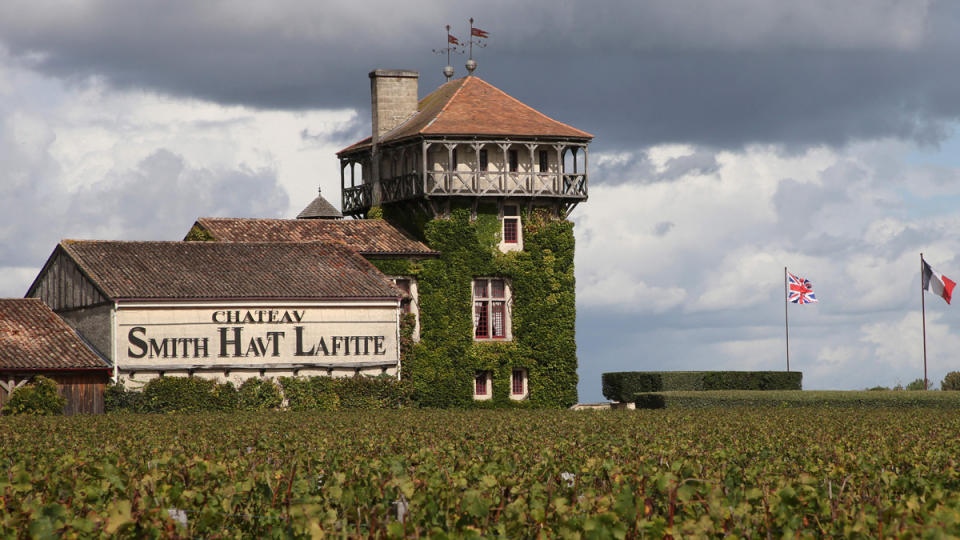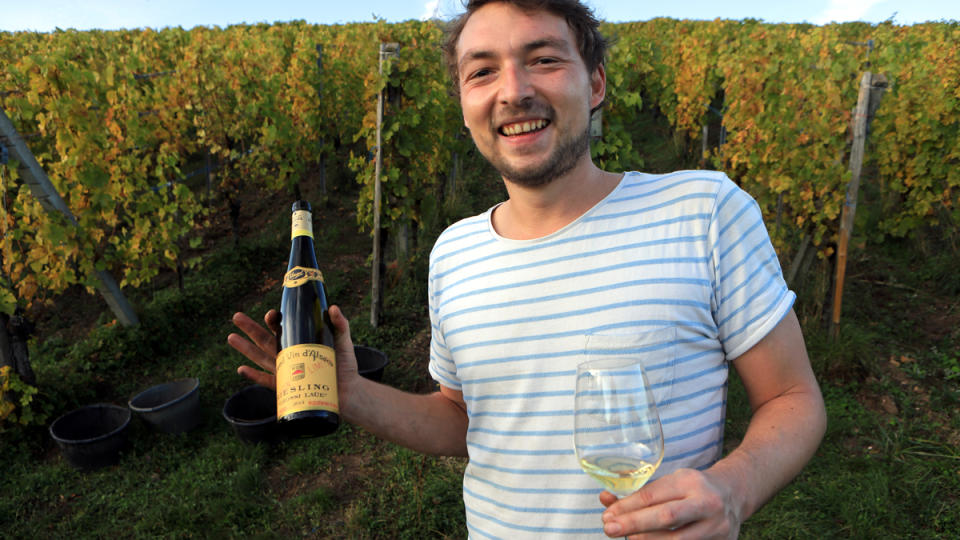Here’s What ‘Cru’ Really Means on a Wine Label

If you want a straightforward document about the wine you’re about to drink, its label may not be that helpful. As we’ve discussed before with the opaque world of “reserve” and “grand reserve,” “grand cru” and “premier cru” on a wine label aren’t necessarily an arbiter of quality. Sometimes, they’re just empty marketing speak intended to get you to think a wine is of a certain quality. But the terms don’t just come from nowhere, and they can be quite helpful when you know what you’re looking for, so we’ve created this guide to help you decode what it means when you see cru on a label in all its different forms.
What Does Cru Mean?
First up, the word cru, which translates to “growth,” indicates a superior vineyard site; it is associated with terroir and takes into account soil, climate, altitude, and aspect (the direction the slope of a vineyard faces). As a technical term with a real definition within the appellation system, it only has an actual meaning in France. Although cru always indicates the best vineyard sites or estates, its meaning varies slightly from region to region within France. The word grand translates as “great,” while premier means “first.”
More from Robb Report
Exclusive: A Provençal Manor House Just Listed for $19 Million
How This Aussie Winery Is Creating Pinot Noir That Rivals Burgundy Reds
LVMH Sold More Bags and Perfume in 2023 Than France Sold Wine
When Is a Cru Not a Cru?
Not to be repetitive, but cru only has a real meaning within France. We’ve heard the term “American cru” used to describe specific vineyard sites, but this is taking liberties with the word and has no legitimate application. In Italy there has been a movement to map out the best Barolo and Barbaresco vineyards and they are informally referred to as crus, but the actual term used within the DOCG system is Menzione Geografica Aggiuntiva, or MGA. Within France, the designation only references vineyard sites and doesn’t cover any stipulations such as aging time in the manner of an Italian Riserva or Spanish Reserva.
Which Is the Higher Level, Grand or Premier Cru?
This one is tricky. In Bordeaux, premier cru, or first growth, indicates the highest level of vineyard quality, while in Burgundy, grand cru, or great growth, is the tier above premier cru. The best way to make sense of this is to break it out by region.
Bordeaux

A quick refresher on the Bordeaux Classification of 1855 helps to make sense of the various cru designations throughout Bordeaux. In that year brokers from the wine industry were asked by Napoleon III to select the best wines to represent France at the International Exposition of 1855. The top wines from the Médoc were ranked according to price, which at that time was directly related to quality. According to this new system, the top four vineyards or crus produced “first growth wines.” (The 1973 amendment to the 1855 classification system elevated Chateau Mouton-Rothschild from second growth to first, for a new total of five first growths.) The next 14 vineyards were rated “second growths,” the next 14 were rated “third growths,” with the next 10 rated as “fourth growths” and the final 18 rated as “fifth growths.” Unlike other regions in which cru applies to vineyard sites or production areas, in Bordeaux and its sub-regions the designation applies to chateaux, not appellations.
Medoc Grand Cru Classé
These 61 chateaux are referred to in the 1855 Bordeaux Classification, which are further broken down into levels from first growth to fifth growth. There are 21 in Margaux, 18 in Pauillac, 11 in St-Julien, five in St-Estephe, five in the Haut-Medoc, and one in Graves. While grand cru classé is the overarching designation, first growth translates to premier cru, second to deuxième cru, third to troisième cru, fourth to quatrième cru and fifth to cinquième cru. You may also see these written numerically: 1er, 2eme, 3eme, 4eme, and 5eme.
Medoc Cru Bourgeois
This encompasses the 246 chateaux that were originally classified in 1920 (not 1855). The classification was revised in 1932, 1978, and 2010. It includes Chateau Chasse-Spleen, Chateau Monbrison, and Chateau Greysac.
Graves Grand Cru Classé
The 12 chateaux classified in 1959 include Chateau Smith-Haut-Lafitte, Chateau La Mission-Haut Brion, and Chateau Haut-Bailly. (Chateau Haut-Brion, also in the Graves appellation, was classified as a first growth in 1855.)
St-Emilion
This region first ranked its wines in 1955 and revised its regulations in 1996, 2006, 2011, and again in 2022. It is broken out into four different levels, listed from the lowest to the highest: grand cru, grand cru classé, premier grand cru classé B, and at the very top, premier grand cru classé A. As of 2022, the top two are determined in part by an independent panel’s blind tasting.
Burgundy

The top two tiers in Burgundy are grand cru and premier cru, which sit above the broader Bourgogne and village appellations. Again, grand cru, or great growth, is at the top of the heap in Burgundy, with premier cru, or first growth, in second—but still highly revered—position. Burgundy’s grand cru and premier cru vineyards trace their origin to the Cistercian monks who planted Pinot Noir and Chardonnay here in the 12th century.
Bourgogne Grand Cru
There are 33 Burgundy grand cru vineyards, known locally as climats, and all are in the Côte d’Or. Wines will be labeled with only the name of the cru, not the surrounding village. Among these are such renowned names as Corton-Charlemagne, Romanée-Conti, Clos de Vougeot, Échezeaux, and Bâtard-Montrachet. Sixty percent of the production from grand cru vineyards is red and 40 percent is white; totaled they account for about 1 percent of the region’s production, which explains their scarcity and expense.
Bourgogne Premier Cru
Representing about 18 percent of Burgundy’s annual output, there are 640 premier cru vineyards, also referred to as climats, in the Côte d’Or and Côte Chalonnaise. Premier cru bottlings will list the village and cru on the label; examples include Beaune Premier Cre Clos de Mouche, Mercurey Premier Cru Clos l’Eveque, and Nuits St George Premier Cru Rue des Chaux. You may see premier cru labels with a village name followed by the premier cru designation, such as Morey St Denis Premier Cru, meaning that grapes came from multiple first growth sites within the appellation. Wines are also often labeled with the village and vineyard name followed by 1er Cru.
Chablis Grand Cru
In Northern Burgundy, just east of the town of Chablis, a single contiguous area of vineyards makes up the Chablis Grand Cru appellation. It is divided into seven vineyard sites or climats: Blanchot Bougros, Grenouilles, Les Clos Preuses, Valmur, and Vaudésir, which account for around one percent of regional production. Bottles may be labeled Chablis Grand Cru followed by a single vineyard name; a label reading simply Chablis Grand Cru indicates wine made with grapes from more than one grand cru vineyard. There are also 40 Chablis Premier Cru sites. Many of these climats trace their footprint and origin to the 15th century.
Alsace Grand Cru

Within a 75-mile-long strip of vineyards in Alsace, 51 sites are designated as grand cru vineyards. All of them are the slopes and foothills of this mountainous region, with none on the valley floor. The first grand cru designations were made in 1975 and others were added in 1983, 1982, and 2007. Riesling is the most widely grown grape here while Gewürztraminer, Pinot Gris, and Muscat are also cultivated. Some of the top crus are Geisberg, Hengst, Muenchberg, Rangen, Schoenenbourg, Schlossberg, and Vorbourg.
Cru Beaujolais
In Beaujolais, the home of the Gamay grape, the word cru refers to ten subregions rather than individual vineyard sites. They are Amour, Brouilly, Chénas, Chiroubles, Côte de Brouilly, Fleurie, Juliénas, Morgon, Moulin-à-Vent, and Régnié. While seven of the Beaujolais crus are named for villages, Brouilly and Côte de Brouilly take their monikers from the area around Mont Brouilly, and Moulin-à-Vent, which is between Chénas and Fleurie, takes its name from a local windmill.
Rhone Valley
Like its northern neighbor Beaujolais, the Rhône Valley does not have official designations for grand or premier cru vineyards; rather, the term cru refers to 16 named villages or production area, such as Châteauneuf-de-Pape, Condrieu, Hermitage, Saint-Joseph, and Côtes-Rôtie. Each appellation has its own regulations for allowed grape varieties.
Best of Robb Report
Why a Heritage Turkey Is the Best Thanksgiving Bird—and How to Get One
The 10 Best Wines to Pair With Steak, From Cabernet to Malbec
Sign up for Robb Report's Newsletter. For the latest news, follow us on Facebook, Twitter, and Instagram.

